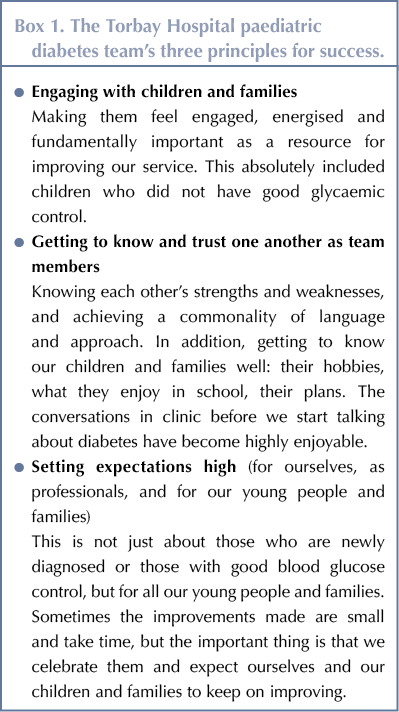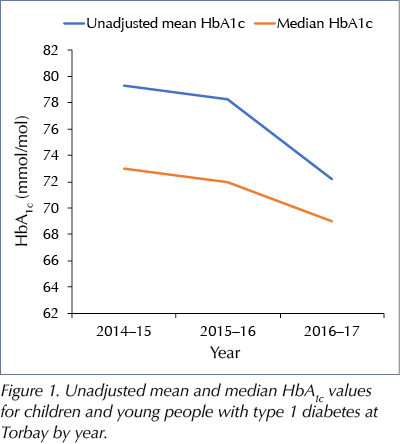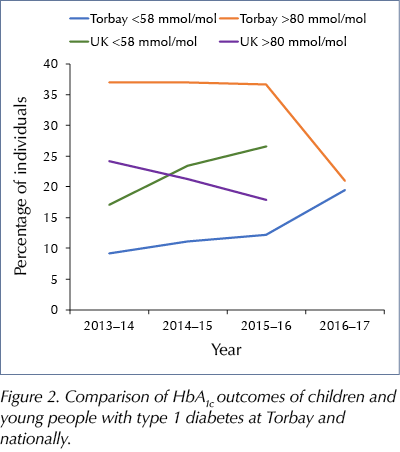We are the Torbay Hospital paediatric diabetes team. We care for children from a large catchment area encompassing a very beautiful stretch of South Devon, including moor and coastline. It is an area of high social deprivation and a significant proportion of our children and families require some form of social support. Our case load comprises, at any one time, between 130 and 140 children and young people.
We were delighted to have the opportunity in 2017 to speak at the National Paediatric Diabetes Audit (NPDA) inaugural conference about our journey as a relatively new team and the fundamental principles we have built our team ethos on. We have learnt a great deal from the good practice of other centres and have incorporated ideas from a wide variety of other teams. This has largely come about through being part of a very supportive network, the National Children and Young People’s Diabetes Network, where teams have shared their successes and difficulties. We are really pleased, therefore, to contribute to the national discussion about how to continue to improve the healthcare and quality of life of children and young people with diabetes and their families.
We hope this article will be helpful to other centres, particularly those with relatively new teams who are starting out on quality improvement programmes. We want to demonstrate how the national focus on children’s diabetes, through initiatives like the Best Practice Tariff, NPDA and the National Peer Review Programme, has helped our team to get the resources needed to do things differently, and the positive impact this has had on often quite disadvantaged families in our area. However, we also want to highlight that much of the intervention and hard work engaging and caring for our patients, although hugely important to individual children and families, is not captured or acknowledged in the outcomes published in the NPDA. We believe we also need to look holistically at the achievements of paediatric diabetes units and find novel approaches to capture this work in the NPDA outcomes.
Development of the Torbay team
Our team became fully staffed in 2015 and was, at that point, a negative outlier in the NPDA care outcomes. We felt we had a unique opportunity to set the foundations and direction of travel for our team to grow towards becoming an excellent paediatric diabetes service. Our starting position allowed us, on a personal and professional level, to empathise with children and young people who may be struggling with their blood glucose control, and we wanted to make them central to the journey of change we were embarking on.
Through a series of meetings, we agreed on three principles for success (Box 1).
Transition
One aspect that we have focused on, and made changes to that reflect these principles, is our transition service. We are very fortunate to have developed a close working relationship with our colleagues from the adult diabetes team. This was achieved through away days and regular meetings. We have worked hard at busting the myths held about the differences in ethos and the way our services operate, and, ultimately, have acknowledged that both services care equally and passionately about our young people and their diabetes care. We also each gained a much better understanding of how the other team works, including the time and resources allocated to diabetes care provision. We have focused during these meetings on producing a unified message so that, regardless of which member of the team is working with a child or family, the central message is the same.
We have developed a transition process with a gradual handing over of care to our adult colleagues, with young people seeing one of the adult diabetologists once in their 15th year, twice in their 16th, three times in their 17th and four times in their 18th. These consultations are held in the familiar setting of the paediatric outpatient department, with paediatric diabetes nurses and dietitians present. Monthly, combined team meetings ensure effective transfer of information. Ultimately, transfer of young people to the care of the adult team occurs when the young person is ready.
Engagement
Our ethos has been to stick with young people, however difficult. In some instances, we have been one of very few constants in their lives. Getting our psychologists to train us in skills such as motivational interviewing has really helped us to engage young people who historically have been difficult to reach. By trying to meet young people on their terms, focusing on what matters to them, being flexible and trying different approaches learnt from one another, we have succeeded in engaging those who, in some instances, had previously refused to come to clinic. It is really heart-warming when we see these young people getting through difficult times and starting to take care of their health and their future.
Outcomes
We are pleased that, with this fresh approach and focus on the key principles set out above, our HbA1c care outcomes have improved significantly over the last few years (Figure 1 and Figure 2), and we have had such positive feedback from families and children. There is still a long way to go, but we feel we are now functioning cohesively as a team and are very optimistic for the future.
The gaps in audit
Whilst wanting to demonstrate how the NPDA has benefitted our service in achieving these changes by focusing attention and resources to improve our performance, we also wanted to highlight what it is failing to capture and how, for our families, it is not all about numbers.
Children’s and young people’s services are involved, in some capacity, with 15% of our case load. As the two case studies outlined with this article illustrate, fighting to get multi-agency input to support some of our families, liaising with and providing reports for these services, and ensuring action plans are seen through has involved a significant amount of time and effort. This has had a huge impact for our children and families, but is not acknowledged within the NPDA outcomes.
Concluding remarks
Ultimately, it is individual lives that we as healthcare professionals want to improve. Progress and success achieved at this level is often not captured or reflected in the NPDA’s care outcomes. These outcome measures often do not tell the story of engagement, persistence and, ultimately, never losing faith that has characterised our team’s engagement with many of our young people with diabetes.
For us and many units like us, there is so much more going on than the audit outcomes describe, and we believe that focus on trying to capture and acknowledge these unsung successes would validate and further motivate diabetes healthcare professionals in their work.
Case study 1
Another example is a 16-year-old girl with an intense fear of hypoglycaemia. She was testing her blood glucose 10–15 times a day and deliberately running very high blood glucose levels. Changes to the team’s structure and ethos have enabled us to make weekly home visits. At each visit, tiny changes have been made, and there has been a real effort to focus not necessarily on the numbers, but on building her confidence and reinforcing positive behaviour, along with lots of encouragement. She is now gradually feeling more confident to test less and let her glucose targets be reduced little by little. In terms of the NPDA, she still has an HbA1c that is terribly high, but for her and the many similar individuals that we work with, we are making huge strides.
Case study 2
Work we have done with one family in particular illustrates the paradox of how, although the NPDA has helped us to do things better, it is not capturing or acknowledging the care and support we are now able to offer. This family includes three children with type 1 diabetes. They have had problems with domestic violence, drug abuse and parental illiteracy.
The eldest son was diagnosed at the age of 10 years. Within a few months, engaging with him and the family became very difficult. Referrals were made to children’s services and a child protection plan was formulated. As part of the plan, weekly visits were arranged by our diabetes nurse. She was unable to sustain these visits for long, partly owing to pressures and demands from the rest of the case load, but also because each visit felt like “Groundhog Day”, with no progress being made. Without support, and beset by the feeling that nothing was changing, the visits became an emotionally draining and dispiriting experience.
More recently, in the last two years, the two younger brothers have also been diagnosed with type 1 diabetes. With a new team ethos and much greater expectations, we are determined that these two will not be allowed to follow in the footsteps of their brother. From diagnosis, the education provided has been more structured and we have been clear with the family what our expectations are.
We experienced similar difficulties around boundary setting and engagement with our services but, with increased resources and a determination that we were not going to give up on this family, the team badgered children’s social services to take the risks of poor diabetes control seriously, and sought support from them. The team has worked closely with the family, often making little or no obvious progress, but not letting that put us off. The boys are visited by one or two members of the team on a weekly basis. We have also worked closely with their school to support their care during the day, and the team have doggedly persisted in trying to find ways to help Mum and the boys grasp the rudiments of carbohydrate counting.
It has taken a lot of time and effort and we are not there yet, by any means, but the diabetes care of the two younger brothers is being prioritised in a way that it was not with the older sibling. A clearer approach has helped the mother in setting boundaries around their diabetes care, and the younger one, in particular, is starting to take an interest in understanding more about his condition. In terms of the NPDA, all of this important work will not be reflected in our outcome figures but, for this family, it is making a big difference.








NHSEI National Clinical Lead for Diabetes in Children and Young People, Fulya Mehta, outlines the areas of focus for improving paediatric diabetes care.
16 Nov 2022